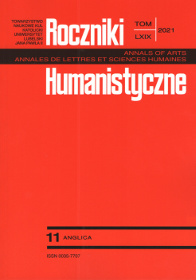“I Want to Go Home”: The Representation of Dual Homecoming in Dorothy Allison’s Cavedweller
Abstract
The aim of the article is to discuss Dorothy Allison’s novel Cavedweller (1998) in terms of the narrative strategies of doubling. The novel features Delia, a woman who returns to the South with her daughter, Cissy, to reconnect with the rest of her family. While Delia’s return to her hometown meets with social ostracism, her daughter manages to find a sense of identity and belonging in the underground caves in Georgia. The two parallel stories of homecoming are presented by Allison through the images of doubling, which help her to confront regional traumas and tensions of the South.
References
Allison, Dorothy. Skin: Talking about Sex, Class & Literature. Fireband Books, 1994.
Allison, Dorothy. Cavedweller. Dutton Book, 1998.
Allison, Dorothy. Interview, 1995. Manufacturing Intellect. www.youtube.com/watch?v= dF5ZYACt6Kw. Accessed 7 July 2021.
Allison, Dorothy. John Adams Talk, 1999. www.youtube.com/watch?v=i7vZQkUX1D0. Accessed 10 July 2021.
Choiński, Michał. Southern Hyperboles: Metafigurative Strategies of Narration. Louisiana State UP, 2020.
Holman, C. Hugh. “The Southerner as American Writer.” The Roots of Southern Writing, edited by C. Hugh Holman, U of Georgia P, 1972, pp. 1–16.
LeMahieu, Michael. “An Interview with Dorothy Allison”. Contemporary Literature, vol. 51, no. 4, 2010, pp. 651–676. DOI: 10.1353/cli.2011.0002.
McPherson, Tara. Reconstructing Dixie: Race, Gender, and Nostalgia in the Imagined South. Duke UP, 2003.
Copyright (c) 2021 Roczniki Humanistyczne

This work is licensed under a Creative Commons Attribution-NonCommercial-NoDerivatives 4.0 International License.





